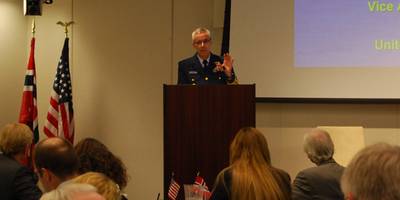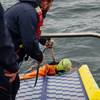US Coast Guard Outlines Arctic Priorities
U.S. Coast Guard (USCG) Vice Adm. Peter Neffenger, the USCG’s Vice Commandant, presented the service’s 2014 Arctic priorities in support of the Coast Guard’s Arctic Strategy at an Arctic-shipping event sponsored by the Norwegian Embassy.
The USCG’s Arctic Strategy is built around three strategic objectives: improve awareness, modernize governance and broaden partnerships in the Arctic region.
“Where there are humans on the water, there is a demand for us to keep them safe and secure and ensure environmental responsibility,” said Neffenger.
As Neffenger discussed the challenges of the Arctic, he stressed the need for situational awareness and integrated coordination among all the resources available.
“It’s not an easy area to operate in, and we need to look at how we bring all of this together in a way that makes sense,” Neffenger added. “We need to work together on knowing what’s there and then determine how we will respond to it.”
The USCG's 2014 Arctic priorities are:
1) Establish an Arctic Coast Guard Forum: This forum will discuss how the Coast Guard will operate in the Arctic. The service anticipates the Arctic Coast Guard Forum will be established this fall.
2) Establish an Arctic Policy Board: The Coast Guard is working with the Department of Homeland Security to create a board under the provisions of the Federal Advisory Committee Act. This board would allow the service to hold meetings with a representative sample of Arctic stakeholders, with diverse and significant specialty knowledge, to advise DHS and Coast Guard policy.
3) Establish a Center for Arctic Strategy and Policy: The center will be at the Coast Guard Academy, in New London, Connecticut to enhance research and expertise for international Arctic operations.
4) Promote waterways management: The Coast Guard will be looking at traffic management and how it could impact the Arctic’s fragile shorelines.
5) Arctic Council engagement: The Department of State will hold the Chairmanship for the Arctic Council in 2015. The Coast Guard is supporting the Department of State and anticipates coordinating a search and rescue and oil spill response exercise during the U.S. chairmanship tenure.
6) Recapitalize polar icebreaker: The Coast Guard is leading an interagency workgroup to develop operational requirements for a national icebreaker.
7) Continue Polar Code development: As part of the International Maritime Organization, the U.S. is collaborating with other nations to develop a Polar Code with supporting guidance and recommended provisions. The code will cover the full range of matters relevant to ships operating in challenging Arctic and Antarctic waters.
8) Improve maritime domain awareness: The Coast Guard continues to study the feasibility of options for maritime domain awareness as the designated lead for Arctic Maritime Domain Awareness by the National Strategy for the Arctic Region.
9) Create an Arctic maritime assistance coordination center: This is a long-term goal to establish an international coordination center for Arctic missions, such as search and rescue.
10) Create an Arctic fusion center: Implement an interagency and international fusion center to collect and disseminate information with partners.
11) Improve communication capabilities: The Coast Guard is working with the Department of Defense to evaluate communication coverage gaps, test satellite capability and identify communications needs to support potential military operations in the Arctic.
12) Arctic Shield Operations: The Coast Guard will continue to support its mobile and seasonal approach to activities occurring in the Arctic.













